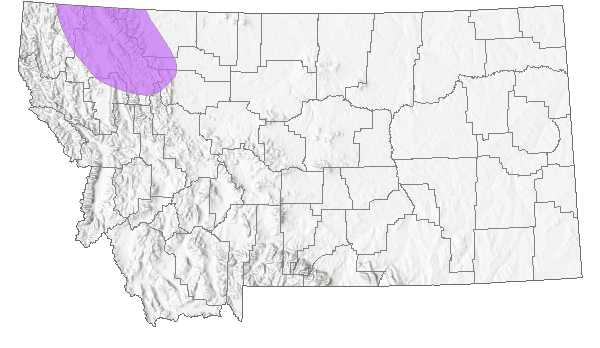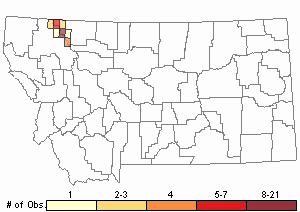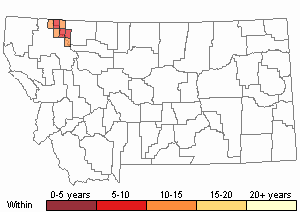View in other NatureServe Network Field Guides
NatureServe
Montana
Utah
Wyoming
Idaho
Wisconsin
British Columbia
South Carolina
Yukon
California
New York
Needle-like Free-living Caddisfly - Rhyacophila belona
State Rank Reason (see State Rank above)
In Montana the species is found in the vicinity of Glacier National Park and is dependent on cold water streams. Loss of glaciers in this region could cause significant impacts to an already limited species.
General Description
Trichoptera is the largest order of insects that is entirely aquatic, with over 12,600 species worldwide (de Moor and Ivanov 2008). Caddisflies are most closely related to Lepidoptera (butterflies and moths), and they share characteristics such as spinning silk. Rhyacophilids make up one of the largest genera of Trichoptera and are some of the most primitive caddisflies.
Caddisflies spend most of their life in the water as aquatic larvae and most species build portable, protective cases made from plant material or stones. Most caddisflies either filter small particles from the water by building nets spun from silk or shredded organic matter (e.g., leaves) into smaller pieces. The genus Rhyacophila is a unique group because they do not build portable cases and are mainly predators. Not all Rhyacophila have gills; those lacking gills absorb oxygen through their skin and thus require cold, oxygen-rich, fast-flowing water to breathe.
Caddisflies typically have five larval instars before pupation. Despite larvae being free-living, Rhyacophila construct a shelter of small stones tied together with silk for pupation, and the pupa uses its mandibles to break through the case and emerge (Anderson 1976). Adults can live anywhere from a few days to several weeks.
Adult caddisflies are medium-sized insects with tent-shaped wings. They resemble moths, but caddisflies do not have a coiled proboscis and their wings are covered in hairs rather than scales. They tend to be secretive and slow-flying riparian insects (Anderson 1976). Rhyacophila usually inhabit cool mountain streams and have small distributions, often restricted to only one or two mountain ranges (Anderson 1976).
Diagnostic Characteristics
Larval
Rhyacophila belona has an orange head with darker muscle scars. The head is at least 1.7 times longer than wide. Its right mandible has three apical teeth with a long projecting middle tooth, while its left mandible has two apical teeth with the lower tooth being longer. This
Rhyacophila species does not have gills.
The larvae of
Rhyacophila belona closely resembles
R. unimaculata, but the latter has a darker brown head with lighter muscle scars.
R. unimaculata is also plumper and its foreleg’s tarsus is shorter than its claw. Giersch and Wisseman (2012) provide a key to identify larval
Rhyacophila.
Adults of
R. belona have not been described.
Species Range
Montana Range
Range Descriptions

 Native
Native
Range Comments
Few observations of Rhyacophila belona are known, but they have been reported from Montana, Wyoming, Alberta, and British Columbia (Giersch and Wisseman 2012). This species is known only from the Glacier National Park area in Montana.
Observations in Montana Natural Heritage Program Database
Number of Observations: 40
(Click on the following maps and charts to see full sized version)
Map Help and Descriptions
Relative Density

Recency



 (Observations spanning multiple months or years are excluded from time charts)
(Observations spanning multiple months or years are excluded from time charts)
Habitat
Rhyacophila belona is found in high alpine brooks from 6000 to 7000 feet (Wold 1973). Little is known about exactly what water temperatures this species inhabits, but many Rhyacophilids live in cold-water streams.
Rhyacophila vao was recorded in a stream with an average annual water temperature of 3.7?. Additionally,
R. vao was found to not pupate until stream temperature exceeded 3? (Dixon and Wrona 1992).
Rhyacophila belona is also likely a cold-water stream inhabitant.
More sensitive taxa (caddisflies, mayflies, and stoneflies) are usually found in areas with less deposited sediment, while the abundance of tolerant taxa (fingernail clams, scuds, and non-biting midges) increases with the percent of fine sediment in the stream (Waters 1995, Cole et al. 2003).
Many studies found that macroinvertebrate densities decrease as forest stand age increases; however, these young stands exhibit higher dominance by just a few taxa that are tolerant to disturbance due to increased solar radiation increasing primary production (Cole et al. 2003). Older stands show lower dominance of tolerant taxa likely because stream conditions are more stable, thus allowing the abundance of sensitive taxa like caddisflies to increase.
Food Habits
Larval rhyacophilids are predaceous, and R. belona’s prey probably includes Chironomidae (non-biting midge) and other small fly larvae, Ephemeroptera (mayfly), Plecoptera (stonefly), other Trichopterans, Copepoda (crustacean), Acari (water mite), and even fish eggs (Thut 1969, Dudgeon and Richardson 1988). Feeding patterns may change throughout larval instars. Earlier instars may have a diet dominated by moss, diatoms, and detritus, but then later eat more animal material after the third instar. Rather than engulfing their prey whole, larval Rhyacophila only consume the soft parts of their prey, discarding tougher structures like legs and head capsules (Giersch 2002).
Little is known about the diet of adult Rhyacophila, but other adult caddisflies do not have developed mouthparts and only eat nectar or sap from plants during their short time as an adult.
Ecology
Rhyacophila species are often sympatric, with several species occurring together at one site (Giersch 2002).
Reproductive Characteristics
The lifecycle of R. belona has not been studied. Most caddisflies have a one-year life cycle, though some species reproduce more than once per year and others require two years to fully develop. Some species that are univoltine in lower elevation temperate streams may be semivoltine (more than one year) at higher latitudes or elevations where the growing season is too short for larvae to complete development in one year (Giersch 2002). After a short pupation phase, Rhyacophila transitions from the aquatic to the terrestrial environment. Little is known about the emergence time of adult R. belona, but they likely have a flight season primarily during the month of July (Wold 1973).
Caddisfly adults tend to remain near the emergence site where oviposition occurs. Although dispersal flights are common, they are relatively short and only occur immediately following emergence. Dispersal from emergence sites tends to be negatively correlated with vegetation density (Collier and Smith 1998). In other words, caddisflies tend to disperse shorter distances in dense forest compared with more open areas.
Management
R. belona is a regional endemic only known to occur in high alpine snowmelt and spring fed streams along the Rocky Mountain Cordillera in Glacier National Park of Montana, Waterton, Banff and Jasper National Parks of Alberta & British Columbia. With the increased advancement of global warming, this species could be considered a candidate for the USFWS T&E species list.
Stewardship Responsibility
Threats or Limiting Factors
There are no known specific threats to Rhyacophila belona, but threats to many Rhyacophila in Montana include sediment and temperature increases resulting from road building, timber harvests, and other disturbances in forested riparian areas (Stagliano et al. 2007). Global climate change is also predicted to pose a threat to R. belona and other cold-water, mountain stream insects.
References
- Literature Cited AboveLegend:
 View Online Publication
View Online Publication Anderson, N.H. 1976. The distribution and biology of the Oregon Trichoptera. Oregon Agricultural Experiment Station Technical Bulletin 134:1-152.
Anderson, N.H. 1976. The distribution and biology of the Oregon Trichoptera. Oregon Agricultural Experiment Station Technical Bulletin 134:1-152. Cole, M.B., K.R. Russell, and T.J. Mabee. 2003. Relation of headwater macroinvertebrate communities to in-stream and adjacent stand characteristics in managed second-growth forests of the Oregon Coast Range mountains. Canadian Journal of Forest Research 33:1433-1443.
Cole, M.B., K.R. Russell, and T.J. Mabee. 2003. Relation of headwater macroinvertebrate communities to in-stream and adjacent stand characteristics in managed second-growth forests of the Oregon Coast Range mountains. Canadian Journal of Forest Research 33:1433-1443. Collier, K.J. and B.J. Smith. 1998. Dispersal of adult caddisflies (Trichoptera) into forests alongside three New Zealand streams. Hydrobiologia, 361: 53-65.
Collier, K.J. and B.J. Smith. 1998. Dispersal of adult caddisflies (Trichoptera) into forests alongside three New Zealand streams. Hydrobiologia, 361: 53-65. de Moor, F.C. and V.C. Ivanov. 2008. Global diversity of caddisflies (Trichoptera: Insecta) in freshwater. Hydrobiologia 595:393-407.
de Moor, F.C. and V.C. Ivanov. 2008. Global diversity of caddisflies (Trichoptera: Insecta) in freshwater. Hydrobiologia 595:393-407. Dixon, R.W.J. and F.J. Wrona. 1992. Life history and production of the predatory caddisfly Rhyacophila vao Milne in a spring-fed stream. Freshwater Biology 27:1-11.
Dixon, R.W.J. and F.J. Wrona. 1992. Life history and production of the predatory caddisfly Rhyacophila vao Milne in a spring-fed stream. Freshwater Biology 27:1-11. Dudgeon, D. And J.S. Richardson. 1988. Dietary variations of predaceous caddisfly larvae (Trichoptera: Rhyacophilidae, Polycentropodidae and Arctopsychidae) from British Columbian streams. Hydrobiologia 160(1):33-43.
Dudgeon, D. And J.S. Richardson. 1988. Dietary variations of predaceous caddisfly larvae (Trichoptera: Rhyacophilidae, Polycentropodidae and Arctopsychidae) from British Columbian streams. Hydrobiologia 160(1):33-43. Giersch, J. and R. Wisseman. 2012. Annotated list of Rhyacophila of North America with larval key and descriptions. U.S. Geological Survey, Southwest Assoc. of Freshwater Invertebrate Taxonomists Workshop 2012. 133 p.
Giersch, J. and R. Wisseman. 2012. Annotated list of Rhyacophila of North America with larval key and descriptions. U.S. Geological Survey, Southwest Assoc. of Freshwater Invertebrate Taxonomists Workshop 2012. 133 p. Giersch, J. J. 2002. Revision and phylogenetic analysis of the verrula and alberta species group of Rhyacophila pictet 1834 with description of a new species (Trichoptera: Rhyacophilidae). Master's of Science Thesis. Montana State University, Bozeman, MT. 206 pp.
Giersch, J. J. 2002. Revision and phylogenetic analysis of the verrula and alberta species group of Rhyacophila pictet 1834 with description of a new species (Trichoptera: Rhyacophilidae). Master's of Science Thesis. Montana State University, Bozeman, MT. 206 pp. Hrovat, M. and G. Urbanic. 2012. Life cycle of Rhyacophila fasciata Hagen, 1859 and Hydropsyche saxonica McLachlan, 1884 in a Dinaric karst river system. Aquatic Insects 34(1):113-125.
Hrovat, M. and G. Urbanic. 2012. Life cycle of Rhyacophila fasciata Hagen, 1859 and Hydropsyche saxonica McLachlan, 1884 in a Dinaric karst river system. Aquatic Insects 34(1):113-125. Martin, I.D. 1985. Microhabitat selection and life cycle patterns of two Rhyacophila species (Trichoptera: Rhyacophilidae) in southern Ontario streams. Freshwater Biology 15:1-14.
Martin, I.D. 1985. Microhabitat selection and life cycle patterns of two Rhyacophila species (Trichoptera: Rhyacophilidae) in southern Ontario streams. Freshwater Biology 15:1-14. Stagliano, D.M., G.M. Stephens, and W.R. Bosworth. 2007. Aquatic invertebrate species of concern on USFS northern region lands. Montana Natural Heritage Program, Helena, Montana and Idaho Conservation Data Center, Boise, Idaho. 153 p.
Stagliano, D.M., G.M. Stephens, and W.R. Bosworth. 2007. Aquatic invertebrate species of concern on USFS northern region lands. Montana Natural Heritage Program, Helena, Montana and Idaho Conservation Data Center, Boise, Idaho. 153 p. Thut, R.N. 1969. Feeding habits of larvae of seven Rhyacophila (Trichoptera:Rhyacophilidae) species with notes on other life-history features. Annals of the Entomological Society of America 62(4):894-898.
Thut, R.N. 1969. Feeding habits of larvae of seven Rhyacophila (Trichoptera:Rhyacophilidae) species with notes on other life-history features. Annals of the Entomological Society of America 62(4):894-898. Waters, T.F. 1995. Sediment in streams: Sources, biological effects, and control. American Fisheries Society, Bethesda, Maryland. Monograph 7.
Waters, T.F. 1995. Sediment in streams: Sources, biological effects, and control. American Fisheries Society, Bethesda, Maryland. Monograph 7. Wold, J.L. 1973. Systematics of the genus Rhyacophila (Trichoptera; Rhyacophilidae) in western North America with special reference to the immature stages. M.Sc. Thesis. Corvallis, OR: Oregon State University. 229 p.
Wold, J.L. 1973. Systematics of the genus Rhyacophila (Trichoptera; Rhyacophilidae) in western North America with special reference to the immature stages. M.Sc. Thesis. Corvallis, OR: Oregon State University. 229 p.
- Additional ReferencesLegend:
 View Online Publication
View Online Publication
Do you know of a citation we're missing? Gustafson, D. L. 1990. Ecology of aquatic insects in the Gallatin River drainage. Ph.D. Dissertation. Bozeman, MT: Montana State University. 194 p.
Gustafson, D. L. 1990. Ecology of aquatic insects in the Gallatin River drainage. Ph.D. Dissertation. Bozeman, MT: Montana State University. 194 p. Muhlfeld, C.C., T.J. Cline, J.J. Giersch, E. Peitzsch, C. Florentine, D. Jacobsen, and S. Hotaling. 2020. Specialized meltwater biodiversity persists despite widespread deglaciation. Proceedings of the National Academy of Sciences May 2020, 202001697; DOI: 10.1073/pnas.2001697117
Muhlfeld, C.C., T.J. Cline, J.J. Giersch, E. Peitzsch, C. Florentine, D. Jacobsen, and S. Hotaling. 2020. Specialized meltwater biodiversity persists despite widespread deglaciation. Proceedings of the National Academy of Sciences May 2020, 202001697; DOI: 10.1073/pnas.2001697117
- Web Search Engines for Articles on "Needle-like Free-living Caddisfly"
- Additional Sources of Information Related to "Insects"





